I would like to preface this article by stating that this article, at the time of its writing, covers the state of Weiss Schwarz in its current iteration in Fall 2023.


I do love this game. From my own bio on this site, I’ve been playing this game for several years now since late 2013 after I first saw a trial deck for Bakemonogatari in English on sale at a local anime convention. Ever since then, thousands of dollars poured in and several friendships formed, I’ve had quite a number of years having fun and messing about. At this point, I honestly feel like I should be looking for a cane and calling every new player a “whippersnapper”.
I’ve seen the game go through many transitions. Heck, when I first began playing the game, the game barely had anything one could even remotely consider a meta compared to what currently exists today. Back then, many of the so-called profiles didn’t exist. Having a brainstorm that gave you hand was a luxury (they were also rest two). People weren’t even running climax combos, relying upon eight door triggers as a way to maintain hand.
For the most part, I do think the changes made in the past decade have made the game significantly better. Cards are just much more efficient at what they do, coupling filtering abilities on top of providing a body on board. There are far more ways to tamper with your deck, gain additional resources, and get what you need to hand. The game feels much more fluid and more enjoyable compared to what my friends may call the old “caveman” Weiss days of mostly vanilla effects and climax slamming.
Now, the obvious question for the reader may be asking why then, if I’m referring to the past, am I showing a picture of Gura’s level three combo. Well, I don’t think any other card screams modern card game design better than her. Gura is a powerful finisher that carries power, a healing ability, and also a powerful finish that is capable of doing multiple instances of damage. Gura’s combo is so powerful and self-reliant that it can easily swing games in your favour with even a single copy on the board.
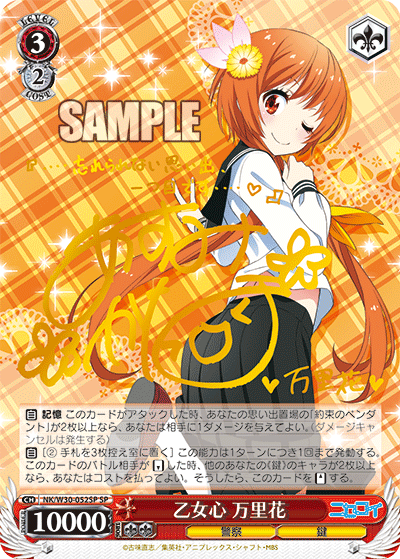
And before I appear to be like an old man bickering into the wind, let me state that cards that had multiple instances of damage have existed long in the past. In fact, one of the earliest decks that I argued (feel free to check out our history series here) was a similar beater that also carried four instances of damage. In fact, Marika could be considered even less reliant since she could perform her ability, given you carried the resources, without a climax combo.
Marika, during her limited time in the spotlight, was quickly banned shortly after her debut that same year. In fact, only recently within this year has she been set free and unbound once again. There was even a shocking video of a player torching his copies of his Marikas as a response to the initial ban list. The reason for Marika’s ban was clear and straightforward. She was overly powerful at the time of her release. Games in any competitive capacity were based solely around her. Decks were modified to optimize themselves to cater to her directly. Furthermore, there were very few counter-plays to her as a whole (the rare exception being something like a money counter from Little Busters!). As a result, Marika was relegated to a single copy throughout the years with the only exception being if you ran a pure Marika waifu deck.
I think this is one of the best comparisons that can be made to really reflect the attitude of the times. When you think about it, both Marika and Gura are the same in conception albeit the changes in powercreep and optimization of abilities. Both perform an overly powerful finish that can quickly ramp up in large amounts of damage through multiple instances of damage. Both are relatively self-reliant and carry little to no condition at all, or if they do, these conditions they require are more than likely expected to be used in their decks or easily met.
Now what is the difference between them? Why bother showcasing this at all other than forming a discussion about the changes in powercreep. The concern I wish to bring up is thinking about changes in design philosophy as a whole. I do understand that at the time of this writing, Gura has been limited in some capacity, but even then, Gura, in my opinion, is just a symbol or portrayal of the general attitude of the game in its current state.
Marika was considered very unhealthy during her time in the spotlight. Games were finished fast with her out on the stage. Three copies could easily lead to a twelve instances of damage, and at the peak of her power, there was little any player could do to avoid the damage or even have a semblance of a chance to play the following turn. Furthermore, even if the opposing player to the Marika player was at level two or less, Marika could very easily make up or compensate for the differences in life totals. That was the attitude back then and the part of the rationale behind her ban along with the fact that she dominated the competitive scene.
We look back on that and consider Weiss in its current state. Gura effectively does the same thing, but Gura is only one of the cards that contributes to this issue. Gura may be an extremity even when compared to other finishers of modern sets. Still, even then, the bitter reality is that modern decks essentially strive to create a similar Marika-esque finish. Games are not meant to stagnate at level three. In fact, it’s not too uncommon to have a player simply skip their entire level three turn and jump from level two to four, not having a single turn to play their own finisher.

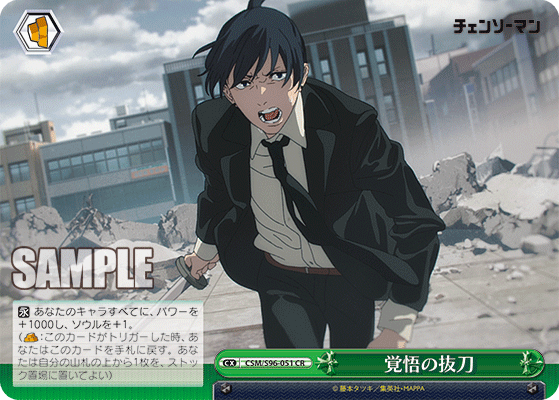
Even finishers like Aki above that seem to have a rather limited finishing capacity is just an outright lie. Aki combos with the card below which gives him further opportunity to trigger his finishing ability. Even though he has a powerful finish, letting you deal multiple points of damage equal to the number of climaxes revealed with his ability, it’s not entirely random as his card may suggest. The fact of reality is that the card below gives him the opportunity to dig through his opponent’s deck to further push for optimal chances to trigger his ability. Furthermore, the ability even stacks with multiple copies of Easy Revenge!.

Now I’ve never really been a big fan of these sorts of abilities. To me, the fact that many of these new finisher’s damage abilities are triggered either at the start of climax phase or at the beginning of their attacks, makes counters much worse and obsolete in many situations. Counters are one of the most fun aspects of the game, giving one of the only forms of interaction during your opponent’s turn. The fact that many of the modern finishing abilities are triggered before the trigger step denies your ability to use these powerful effects entirely. Given that these finishers can potentially end you with a single copy by themselves, it does make me question from time to time if there’s even a point to running any sort of counter-play over relying completely on plain dumb luck.
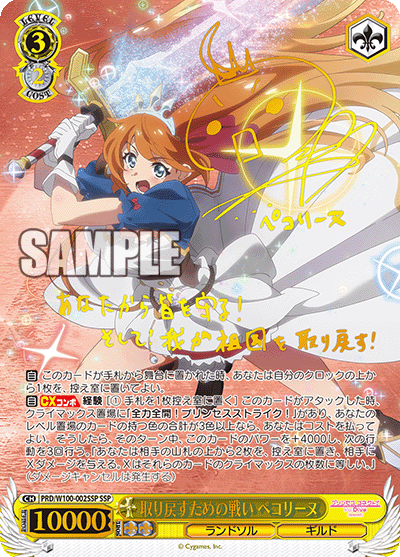
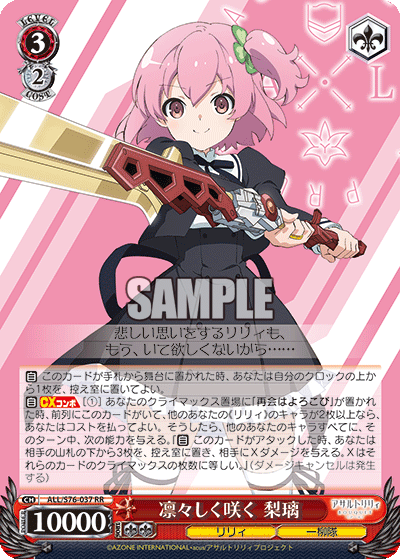
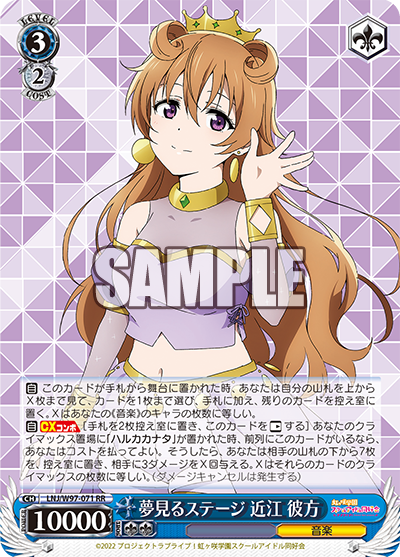
ALL/S76-037RR 凛々しく咲く 梨璃 (middle)
LNJ/W97-071RR 夢見るステージ 近江 彼方 (right)
That’s not to say that earlier forms of this didn’t already pre-exist in the game itself. Just a meta earlier, the game was filled with sets that capitalized off of dealing ridiculous amounts of damage that largely punished your opponent for essentially playing the game in an efficient way. For instance, Pecorine punished your opponent for having climaxes on the top of their deck, and even capable of potentially single handedly depleting your opponent of climaxes in one unfortunate swing. Lily gave another character the ability to Icy Tail chain on a re-standing card, checking to see if your opponent was unlucky enough to have climaxes on the bottom of their deck and punishing them more if they did several times. Kanata, arguably the biggest offender here, completely ignored counters with her ability and did a staggering amount of damage if your opponent was unlucky in their bottom seven cards, a whopping seven cards meaning almost a fifth of any base deck.
And here’s the thing, all these finishers above and even Aki, punish your opponents for having a compressed deck. Essentially, if your opponent played well and managed to keep their stock clean while having climaxes in their deck to potentially cancel, they made the mistake of doing so by game design. It’s undeniable that effects like these have to exist; otherwise, games would devolve into a stalemate of back and forth cancels with some unlucky loser eventually taking damage. However, is it necessary that cards have to be given so many multiple damage instances? And even then, the costs on these cards are essentially non-existent as are their conditions.
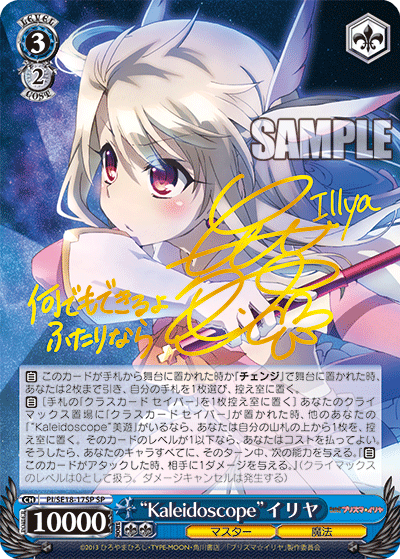
That’s not to say old decks were incapable of this kind of power. However, they were often met with strict restrictions that were costs for these powerful abilities. This ideology or balanced design seems to have been lost or changed with time.

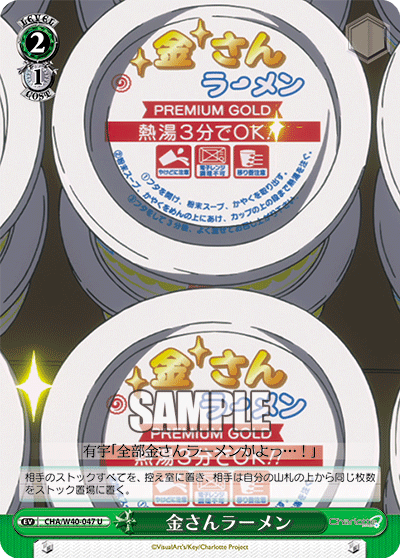
I am already on the fence regarding this above ability. I understand that it is a necessary evil just to make sure a game can properly end without everything turning into a compression war. My question for the design team is that is it necessary for finishers to carry such power and finality in their designs. The game has been pushed to the point where you simply have to drop your finisher and kill because otherwise, you would indefinitely be dead the following turn. There is no comeback. There is no second chance. Finishers no longer just “finish” the match by securing the last points of damage. They are also forcibly used to compensate for missing damage, killing your unprepared or unfortunate opponents as early as their mid game. And the fact of the matter is this is how everything has to be. You cannot print a slower finish because you will simply be overwhelmed by giving your opponent that extra turn.
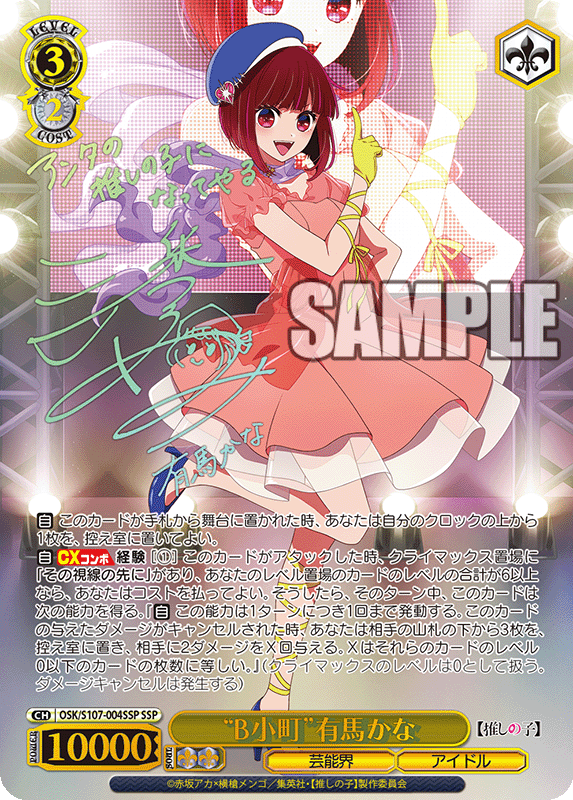
This card above is an upcoming card shown during a recent Weiss reveal a short while back. Kana’s finishing ability is that when she attacks, she gains the ability where if your opponent cancels her damage, you get to mill the bottom three cards of your opponents deck and ping two damage for each level zero or climax card revealed. I think this is absolutely egregious. This card is telling your opponent to eat her damage or otherwise take up to three instances of two damage each. Granted, there is some RNG to the ability, but even then, why is it that your opponent’s cancels can potentially cause them to take so more damage as a result? Why is there such a dire punishing ability for your opponent to properly use a game mechanic (cancelling)?


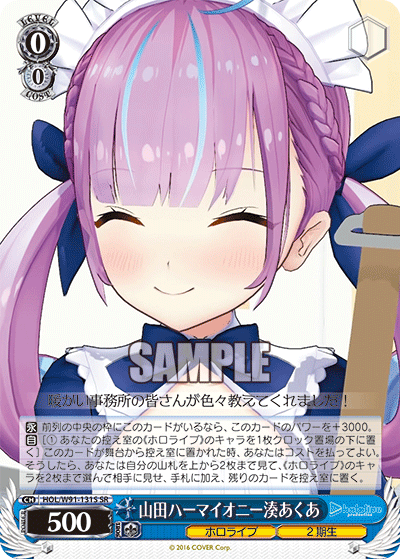
HOL/W91-T031TD 残酷な事実 アキロゼ (middle)
HOL/W91-131C 山田ハーマイオニー湊あくあ (right)
One other issue I wish to draw attention to is the loss in design for certain mechanics. Back then, there was a technique labelled as “level locking”. For those unfamiliar, the idea is that you leave your opponent at a level with four or five cards in clock, keeping them behind the next turn and unable to level up to use more powerful abilities or cards. However, this technique feels obsolete with the design of multiple Riki profiles in a set, forcing a level if need be regardless of your opponent’s actions. However, this is only a single observation of the depreciation of what I call core mechanics.
Weiss is a game of trade. You have to commit resources to gain resources. If you play a card on field, you gain the ability to charge stock or get extra hand with perhaps a combo. There’s a give and take as your committed card will likely be removed by your opponent, setting you back for the following turn. This was always the case up until now. In the current game of Weiss Schwarz, it feels as if resource guarding and proper resource management is more or less a joke. Cards like the Aqua profile give you two hand for minimal cost and risk. You force your opponent to have to run cards to out it or just give you the extra two hand, letting you easily replace cards you threw out for an early tri-field in the front row.


Now you might be thinking that it’s fair to have to run cards to specifically counter-play your opponent’s cards. Yes, that is true. However, a constant reminder in this game is that running counter-play is often more costly to you and only a minor hindrance to your opponent. Modern card designs care very little for any interaction. The best decks are decks that do not care about their opponent’s plays whatsoever, looking to solitaire as much as possible and simply ignoring your opponent’s moves. You having to commit a lane with an Adachi profile or reverse a target with a level reverser opens your field the following turn, letting your opponent capitalize more on your used resources. Furthermore, the card they may have summoned may have been costless to begin with as in the case of standby, creating field for free through a trigger while your opponent has to commit both hand and stock to deal with the cheated out card.
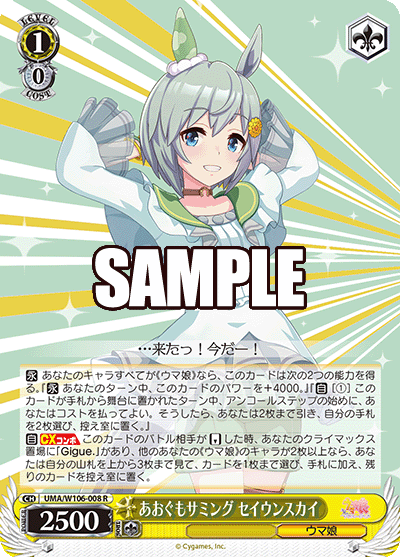

TSK/S82-029SP-SP うまいのだぁ! ミリム (right)
Cards lacking conditions feel as if the decks they are in build themselves at times. They make non-generic cards feel gimmicky and lackluster. These cards shown above have power conditions that are essentially meaningless. As long as you have the generic trait that all cards in that set carry, they fulfill a condition, conditions that are essentially fake. There’s no skill to build around. There’s little concern for failing to meet a certain condition since everything meets everything else’s requirements. It becomes a whole game of “who cares” and “nothing matters”. This isn’t even touching on the fact that some cards that are costless also carry soul triggers, letting you side, a mechanic meant to reduce soul damage to maintain field, for free and still output damage without any demerit.
All in all, what does this mean for the game? I loved this game, and even now, I still very much do. I fell in love with Weiss because it was a game that carried series I enjoyed, fandoms that I remembered in my youth and more that are growing year by year. Why did I max my Lycoris Recoil deck? I don’t really know, but I still love it nonetheless, even if it was a terrible financial decision for my wallet.
I just really wish the game would return to its original roots and kind of give players a bit more agency and at least a few more turns. The game has become far too optimal and sped up with games lasting a little more than four to five turns at most. I also feel as if, with modern decks, I’m not really making many game-changing decisions and the raw power of my finishers just overshadow any early game decisions I have made. And I don’t think it honestly has to be this way. I don’t think having immense amounts of power equates to fun necessarily. I also remember that this game is a two-way street. My opponent is also trying to enjoy the game while playing alongside my cards. Games shouldn’t be a race to the final track and then a burst finish, leaving your opponents in the dust without a response. The decisions you make throughout the game should matter, and ultimately, the results are partially determined by the choices you undertook over others. In that sense, you can re-evaluate your choices and grow from there. However, this just doesn’t feel like the case nowadays.
I know I’ve been rambling on for quite some time now. My local players are about to usher me into the retirement home with a pack of animal crackers after ranting about this for so long. It feels freeing to finally let this entirely out in this post. I don’t mean to be a rambling cynic, but this is just how I honestly feel. But anyways, what do you think? Do you agree with me? What thoughts do you have? I’d love to hear your opinions. It’s okay if you’re wrong. Ruby is better than Kana and Akane, but we can’t all be right.